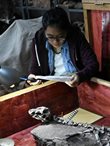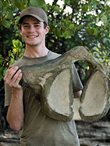 Daniel Cashmore
Daniel Cashmore
Dan is undertaking European Research Council-funded doctoral research into the completeness of the tetrapod fossil record. He is using quantitative approaches to estimate the proportion of preserved skeletal material of numerous tetrapod clades spanning the entire Phanerozoic.
Struan Henderson 
Struan Henderson completed his BSci and MScR degrees at the University of Edinburgh. His PhD research focuses on macroevolutionary trends in Palaeozoic osteichthyan fish, with particular focus on the diversity and distribution of ray-finned fish. He also employs high-resolution CT-scans of fossil fish to determine their internal anatomy and construct 3D models.
View Struan's Google Scholar profile
Fion Ma
Fion is originally from Hong Kong. She completed her MSc at the University of Edinburgh, using geometric morphometrics to study skull form in oviraptorosaurian dinosaurs. For her PhD, she is further exploring oviraptorosaur functional morphology using 3D modelling techniques.
Luke Meade
Luke is undertaking a comprehensive biomechanical study on the skulls of oviraptorosaurs, a group of feathered theropod dinosaurs from the Cretaceous of North America and Asia. These animals are characterised by robust, stubby, often toothless beaks which leave the feeding behaviour and ecosystem position of Oviraptorosauria enigmatic due to a lack of other evidence. He will use 3D data to reconstruct and visualise the skulls and musculature of key taxa (e.g. Incisivosaurus, Citipati, Khaan, Gigantoraptor and Anzu) and conduct biomechanical analyses including finite element modelling to test how their skulls may have functioned. The analyses may reveal patterns of change in the form and function of the skull and lower jaw through the group Oviraptorosauria and whether different skull modifications can be linked as adaptations to specific diets (durophagy, insectivory, herbivory). Ultimately, this may reveal a picture of how complex dietary diversity patterns were in Oviraptorosauria and in other derived theropod groups throughout millions of years. Insight from this may be applied to interpret trends in feeding behaviour in other important extinct and extant taxa and ecosystems.
Romy Rayner
After completing her undergraduate study through the Open University, Romy is undertaking her PhD via distance learning. Her research focuses on patterns of vertebrate diversity and disparity across the Triassic-Jurassic boundary.
 Lisa Schnetz
Lisa Schnetz
Sharks have inhabited this planet for over 400 million years and have maintained their status as top predators up until today. While we know a substantial amount about their history and diversification patterns from later geological periods, little is known about both their early history and diversity. There is a 50-million-year gap between the earliest findings of scales and the first shark teeth, where we have no indication of shark-like properties in the fossil record. Fossils of sharks are rarely preserved beyond the teeth and jaw sections, thus making it more difficult to investigate them. This project will aim to assess and investigate the quality of the fossil record of early sharks using new approaches to estimate the fossil record completeness of early sharks in order to address a series of key questions, including: (1) How complete is the early shark fossil record in comparison with other groups? (2) Is completeness impacted by ecological categories, habitat preferences, and/or body sizes? (3) Are changes in completeness correlated with major changes and shifts in global marine diversity, including evolutionary radiations and mass extinctions? (4) How do changes in completeness correlate with broader estimates of fossil record sampling through time and space?
 Charlotte Bird
Charlotte Bird
Charlotte is utilising digital modelling techniques to reconstruct soft tissue anatomy of early mammal ancestors – cynodonts. Specifically, she is reconstructing the brain of the Triassic cynodont, Thrinaxodon, from CT scans, subsequently assessing the potential for identifying intraspecific variation, sexual dimorphism and developmental stage within endocranial anatomy. Through modelling the brain and inner ear of a plethora of cynodont genera over the evolutionary lineage towards modern counterparts, such as the opossum, Charlotte aims to identify morphological evolution and how this impacted sensory and cognitive capabilities through time. Furthermore, the project will highlight the extent to which biases in the fossil record and digital reconstruction techniques impact the inferences that can be made.
Google Scholar page
 Hannah Bird
Hannah Bird
Hannah's doctoral research focuses on geochemical and biodiversity studies of ichthyoliths (fish and shark teeth, scales and otoliths) from deep sea sediments originating at the Paleocene-Eocene Thermal Maximum (~56 million years ago) - our best analogue for modern and future climate change. This underutilised resource aims to provide a holisitic overview of palaeoceanographic changes and its subsequent impacts upon marine vertebrate communities, as well as the wider effects upon marine trophic webs. Ultimately, this may yield an insightful indication for modern fishing industry practices coping with climate change and link to conservation palaeobiology efforts.
Google Scholar page